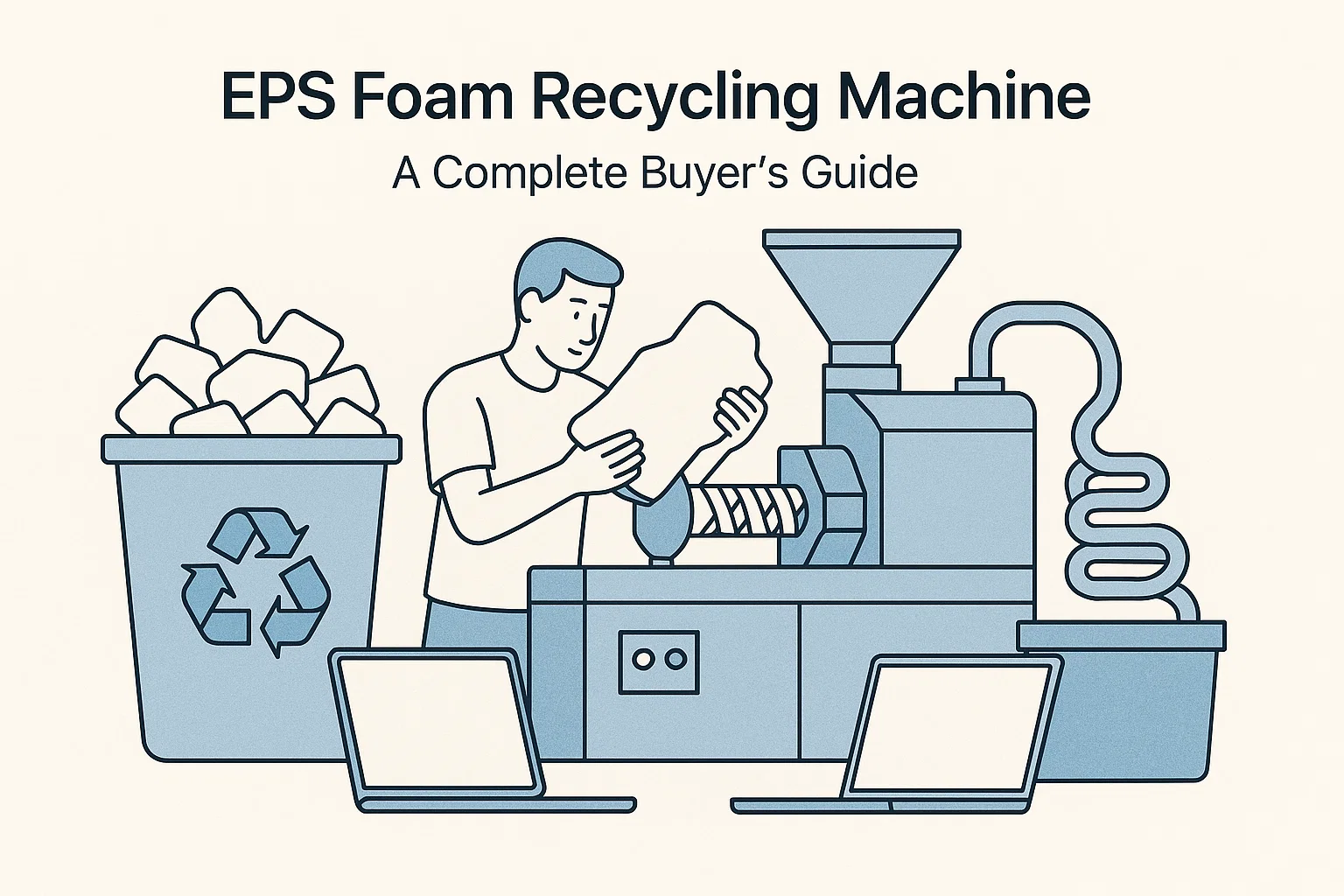A Complete Buyer’s Guide to Choosing an EPS Foam Recycling Machine
Choosing the right EPS foam recycling machine is a critical business decision for any company handling large volumes of expanded polystyrene (often called Styrofoam). This light but bulky waste not only consumes valuable storage space but also leads to high transportation and landfill costs. The right equipment investment can turn this financial burden into a profitable asset.
However, the market is filled with options and technical specifications that can be confusing. This guide provides a clear framework to help you make an informed choice based on your company’s specific needs. We will explain the different types of machines and detail the key factors you must consider.

Why Your Business Needs an EPS Recycling Machine
Before diving into the technical details, let’s clarify the business case for investing in an EPS recycling machine. This is more than an environmental initiative; it’s a smart financial move.
- Drastically Reduce Costs: Up to 98% of EPS foam’s volume is air. A recycling machine reduces this volume by a ratio of up to 50:1 or even 90:1. This means a sharp drop in waste hauling frequency and transportation fees, along with savings on ever-increasing landfill charges.
- Generate New Revenue: Densified EPS blocks or ingots are valuable commodities used to manufacture products like picture frames, architectural molding, and other plastic goods. There is a stable market demand for this material, allowing you to sell it to recyclers for a consistent revenue stream.
- Enhance Corporate Image & Compliance: Implementing an EPS recycling program demonstrates your company’s commitment to sustainability. This boosts your brand image and helps you comply with increasingly strict environmental regulations.
The Core Decision: Cold Compactor or Hot-Melt Densifier?
This is the first and most important choice you will make. Both machines effectively reduce EPS volume, but their operating principles, output, and ideal use cases are very different.
EPS Cold Compactor
How it works: A compactor uses powerful physical force, typically via screw-driven technology, to compress EPS foam into dense, solid blocks. The entire process involves no heat, resulting in lower energy consumption.
- Pros: Low energy use, safer operation (no fumes), and fast startup/shutdown.
- Cons: The compression ratio is generally lower than a densifier (around 50:1), meaning the resulting blocks are slightly larger for the same weight.
EPS Hot-Melt Densifier
How it works: A densifier first shreds the EPS foam, then uses heat to melt it into a paste-like state. It is then extruded and cooled into highly dense ingots.
- Pros: Extremely high compression ratio (up to 90:1), producing very dense, compact ingots that maximize savings on shipping and storage.
- Cons: Requires a pre-heating period, consumes more energy, and must be operated in a well-ventilated area to manage fumes from the melting process.
Explore Our EPS Recycling Machines
Ready to turn your EPS waste into a valuable asset? Discover Energycle Machine’s range of high-performance compactors and densifiers designed for efficiency and reliability.
View Machine Specs7 Key Factors to Evaluate When Choosing a Machine
Once you have a general idea of the machine type you need, it’s time to dive into the details to see if a specific model fits your requirements. Carefully consider these seven factors.
1. Assess Your EPS Waste Volume and Type
This is the starting point for your decision. You need an accurate picture of how much EPS waste you generate daily or weekly. Is it clean, dry foam from packaging, or is it wet and contaminated, like fish boxes?
- Practical Tip: Conduct a one-week “waste audit.” Collect, weigh, and measure the volume of all your EPS scrap. This will give you the baseline data needed to select the right machine capacity.
2. Calculate Required Throughput (Capacity)
Machine capacity is measured in kilograms per hour (kg/hr) or pounds per hour (lbs/hr). Choose a throughput that is slightly higher than your peak waste generation to ensure smooth operations.
- Example Calculation: If you generate 200 kg of EPS waste per 8-hour day, you need a machine with a capacity of at least 25 kg/hr (200 kg / 8 hr). To account for growth, selecting a 40-50 kg/hr model is a safer bet.
3. Compare Compression Ratios
The compression ratio directly impacts your storage and logistics efficiency. A 50:1 ratio means 50 cubic meters of loose foam will be compressed into a 1-cubic-meter block.
- Key Point: Don’t just look at the numbers. Ask for samples of compressed blocks from the supplier to see the density and quality for yourself. A densifier’s 90:1 ratio offers a significant advantage for long-distance shipping.
4. Consider Your Operational Space and Layout
An EPS recycling machine requires a dedicated footprint, including space for the machine itself, a staging area for loose foam, a storage area for finished blocks, and a safe zone for the operator.
- Action Step: Measure the dimensions of the area where you plan to install the equipment. Get the machine’s footprint diagram from the supplier and ensure you have enough room for electrical connections, material flow, and routine maintenance.
5. Check Power and Safety Requirements
Different models have different power requirements (e.g., voltage, three-phase power). Densifiers typically draw more power due to their heating elements and must be installed in well-ventilated areas.
- Safety Tip: Ensure the machine is equipped with standard safety features like emergency stop buttons, overload protection, and safety guards. Confirm with your facility manager that your electrical system can handle the load.
6. Budget and Analyze Return on Investment (ROI)
An EPS recycling machine can range from twenty thousand to over one hundred thousand dollars, depending on its type, capacity, and level of automation. But this is an investment, not just an expense.
- How to Calculate ROI:
- Calculate Annual Savings: (Monthly Hauling Fees + Monthly Landfill Fees) x 12
- Calculate Annual Revenue: (Annual Weight of Recycled EPS x Market Price per kg/lb)
- Annual ROI = (Annual Savings + Annual Revenue) / Total Investment Cost
7. Verify Manufacturer Support and Warranty
Industrial equipment requires long-term service and support. It is crucial to understand the manufacturer’s service network, spare parts availability, and technical support response time.
- Checklist of Questions:
- What is the warranty period and what does it cover?
- Do you provide on-site installation and operator training?
- What is the support process if the machine has an issue?
- What are the costs and lead times for wear parts like blades and screws?
The 4-Step Purchasing Process
With this knowledge, you can now follow a systematic, four-step process to complete your purchase.
Step 1: Internal Waste Audit
Accurately quantify your EPS waste. Document its source, volume, weight, and cleanliness. This is the most important data you will share with suppliers.
Step 2: Initial Vetting & Outreach
Based on your waste volume and site conditions, decide if a compactor or densifier is a better fit. Contact a few reputable suppliers with your audit data for initial recommendations and quotes.
Step 3: Sample Testing & Due Diligence
Send samples of your EPS waste to your shortlisted suppliers for testing. If possible, ask to see a video of the machine in action or visit an existing customer’s site. Seeing is believing.
Step 4: Final Decision & Contract
Compare the equipment performance, price, ROI, and after-sales service. Review the contract terms carefully, especially regarding delivery, installation, training, and warranty, before making a final decision.
Frequently Asked Questions (FAQ)
Q: How much does an EPS foam recycling machine cost?
A: The price varies widely. A small cold compactor might start around $20,000, while a large-capacity hot-melt densifier system can exceed $100,000. The final cost depends on the machine type, capacity, brand, and optional features.
Q: Can I recycle wet or contaminated EPS foam?
A: Yes, but it may require extra steps. For example, fish boxes from seafood markets need to be washed and dried first, as excess moisture and contaminants can reduce compression efficiency and potentially damage the machine. Some advanced models have better tolerance for impurities.
Q: What is the market value of recycled EPS blocks/ingots?
A: Recycled EPS is a valuable commodity. Its price fluctuates with market supply and demand but is generally stable. You can contact local recyclers or plastics manufacturers for current pricing. Your equipment supplier should also be able to provide relevant market insights. For more information, you can check with authoritative sources like the EPS Industry Alliance.
Conclusion
Choosing the right EPS foam recycling machine is a strategic investment that can significantly improve your company’s financial and environmental performance. The key is to thoroughly understand your own operational needs and match them with the technical capabilities of the available machines. Look beyond the initial price and evaluate the long-term value, including operational savings, maintenance support, and return on investment.
By following the steps and evaluation factors outlined in this guide, you can confidently make a smart decision that serves your business’s long-term interests. If you need expert assistance in analyzing your specific situation, the team of specialists at Energycle Machine is ready to help. Visit our homepage at Energycle Machine to explore more solutions.



